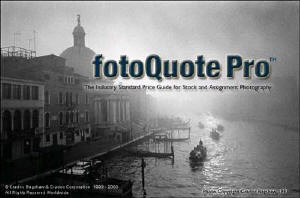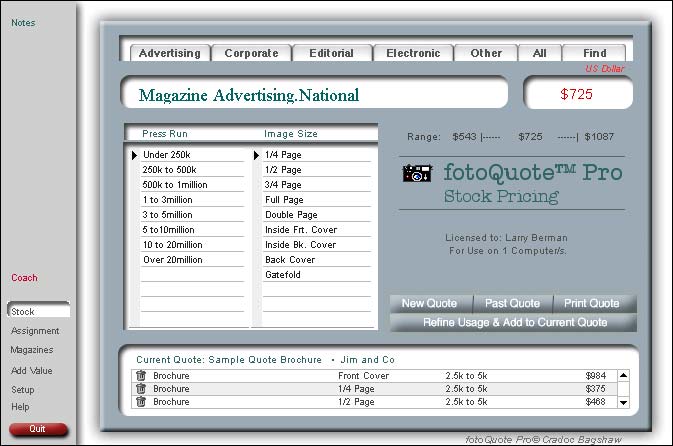|
Using FotoQuote to Price Stock
Photography Sales
Real photographers don’t sell photographs, they license them |
| Pricing Stock Photography
|
|
 A few months ago I received
an e-mail from an advertising agency in Lithuania asking about the use of
my "Gulls" image for a single page in a monthly calendar. I have been
putting my photography on the web for a few years and I’m finding requests
for stock usage of my pictures are increasing. I decided to ask for $200.
That must have been below what they were prepared to pay because they
agreed immediately and asked about purchasing exclusive rights to the
image. That started me thinking about how often I may have under priced my
work, and how much money I may have lost over the years by not knowing the
real value of my photographs. A few months ago I received
an e-mail from an advertising agency in Lithuania asking about the use of
my "Gulls" image for a single page in a monthly calendar. I have been
putting my photography on the web for a few years and I’m finding requests
for stock usage of my pictures are increasing. I decided to ask for $200.
That must have been below what they were prepared to pay because they
agreed immediately and asked about purchasing exclusive rights to the
image. That started me thinking about how often I may have under priced my
work, and how much money I may have lost over the years by not knowing the
real value of my photographs.
Added August 26, 2013
The advertising agency never paid. If you're going to negotiate with foreigh companies, make sure to get paid in advance through Paypal or wire transfer. I licensed an image of Pelé for a bank in Spain and didn't provide the digital file until I had received confirmation of the wire transfer into my checking account. |
Doing a web search for stock photo pricing wasn’t very
helpful, and browsing other stock photo sites quickly showed that pricing
was rarely posted. Each usage request brings different issues to the
table, and there is what seems to be an endless amount of variables to
take into consideration for pricing. Factors such as how the image will be
used, what medium it will be printed on, size of the image, length of time
it will be used, size of the run and purpose of use are just a few of the
elements professionals consider when fairly pricing a stock photo sale.
|
|
FotoQuote™ |
 My research eventually led me
to a program called FotoQuote™ from Cradoc, a name I
remember from my years of shooting stock photographs for submission to The
Image Bank. Cradoc sold a slide labeling program that I had purchased for
my first computer. Since they’ve been connected to the stock industry for
years, I decided to check the program out. My research eventually led me
to a program called FotoQuote™ from Cradoc, a name I
remember from my years of shooting stock photographs for submission to The
Image Bank. Cradoc sold a slide labeling program that I had purchased for
my first computer. Since they’ve been connected to the stock industry for
years, I decided to check the program out.
FotoQuote™ sells for $149.95 for the CD version and
$139.95 for the download. The fotoBiz price is $299 and includes the new
fotoQuote stand alone 5.0 for free.
Both are available in Mac and PC versions. Because stock
sales are a small but growing part of my photography income, I was
primarily interested in using FotoQuote as a reference for quoting prices
when requests for stock usage came in.
|

|
|
A screen capture showing some of
the many factors that go into pricing stock |
Version 5.0 lists over 2000 recommended prices for image
use in 218 categories, making it easy to quote an appropriate fee for use
of a stock photograph. The prices in fotoQuote come from reviewing actual
sales records from stock agencies to the individual photographer
throughout the US. This is important because questionnaires and surveys
are often "wish" prices and not the price the photographer is actually
getting. The prices in fotoQuote are based on US prices. The adjustments
have nothing to do with the country that the image will used. The currency
converter simple lets you convert the prices in fotoQuote into the
Canadian, Australian or New Zealand dollar, the British pound or the Euro. And, because not all price/usage quotes are set in
stone, FotoQuote has a feature called “Stock Coach” that gives tips on
negotiating. In addition to its stock photo pricing calculations,
FotoQuote has a feature that helps photographers quote prices for
assignments. This includes tips on how to deal with clients that want all
rights to the images you shoot while on a job for them. The
RightsWriter™ feature helps build a licensing agreement by selecting
terms from drop down menus. The licensing terms you have selected are
added automatically to your quote before you print it. |
| Real World Pricing |
 So how does FotoQuote work
when put to the test? As I mentioned earlier, my stock photography sales
are growing. Within a week of receiving FotoQuote, I had a request for a
stock sale from an advertising agency wanting one of my New York City
skyline photos for a
full-page ad in the New York Times. The price they quoted me was in the
middle of the range that the program recommended for the specified usage,
leading me to wonder if they were also using FotoQuote. Knowing the range
of possible prices allowed me to negotiate a fee at the upper end of the
price scale. To complete the sale, I only had to upload a 20 megabyte file
of the requested image and we had finished the deal in about 15 minutes.
Isn’t technology wonderful? So how does FotoQuote work
when put to the test? As I mentioned earlier, my stock photography sales
are growing. Within a week of receiving FotoQuote, I had a request for a
stock sale from an advertising agency wanting one of my New York City
skyline photos for a
full-page ad in the New York Times. The price they quoted me was in the
middle of the range that the program recommended for the specified usage,
leading me to wonder if they were also using FotoQuote. Knowing the range
of possible prices allowed me to negotiate a fee at the upper end of the
price scale. To complete the sale, I only had to upload a 20 megabyte file
of the requested image and we had finished the deal in about 15 minutes.
Isn’t technology wonderful?
Thinking back on the image that I licensed to the
Lithuanian company for one time use in a calendar I wondered how much I
lost by not knowing the going rate. Plugging the variables into FotoQuote
brought up a recommended price of about twice what I asked for. Properly
pricing my photograph for that single sale would have been more than
enough to pay for the FotoQuote program. |
| FotoBiz |
| If my photography business
were more commercial and less fine art, I’d look into using FotoBiz
as a full time business aid to organize my photography sales. It provides
all the forms necessary to keep a paper trail of submissions. The latest
version of fotoBiz will not be out until summer 2004. As with all software
development it seems to take much longer than planned. It will also deal
with modern capture and submission technology like shooting digitally (no
film) and submitting image files electronically. |
| Resources |
http://larryberman.com/press.htm
A list of published images on the press page of a new web site I built to attract commercial photography buyers. There are a lot more of my older published sports photographs on BermanSports.com |
Cradoc Corporation
www.fotoquote.com
PO Box 1310
Point Roberts, WA 98281
800-679-0202 |
| Additional Web Resources |
http://www.pickphoto.com
http://photographersindex.com/stockprice.htm
http://photographersindex.com/price-adv-calc.htm |


 A few months ago I received
an e-mail from an advertising agency in Lithuania asking about the use of
my "Gulls" image for a single page in a monthly calendar. I have been
putting my photography on the web for a few years and I’m finding requests
for stock usage of my pictures are increasing. I decided to ask for $200.
That must have been below what they were prepared to pay because they
agreed immediately and asked about purchasing exclusive rights to the
image. That started me thinking about how often I may have under priced my
work, and how much money I may have lost over the years by not knowing the
real value of my photographs.
A few months ago I received
an e-mail from an advertising agency in Lithuania asking about the use of
my "Gulls" image for a single page in a monthly calendar. I have been
putting my photography on the web for a few years and I’m finding requests
for stock usage of my pictures are increasing. I decided to ask for $200.
That must have been below what they were prepared to pay because they
agreed immediately and asked about purchasing exclusive rights to the
image. That started me thinking about how often I may have under priced my
work, and how much money I may have lost over the years by not knowing the
real value of my photographs.  My research eventually led me
to a program called FotoQuote™ from Cradoc, a name I
remember from my years of shooting stock photographs for submission to The
Image Bank. Cradoc sold a slide labeling program that I had purchased for
my first computer. Since they’ve been connected to the stock industry for
years, I decided to check the program out.
My research eventually led me
to a program called FotoQuote™ from Cradoc, a name I
remember from my years of shooting stock photographs for submission to The
Image Bank. Cradoc sold a slide labeling program that I had purchased for
my first computer. Since they’ve been connected to the stock industry for
years, I decided to check the program out.

 So how does FotoQuote work
when put to the test? As I mentioned earlier, my stock photography sales
are growing. Within a week of receiving FotoQuote, I had a request for a
stock sale from an advertising agency wanting one of my New York City
skyline photos for a
full-page ad in the New York Times. The price they quoted me was in the
middle of the range that the program recommended for the specified usage,
leading me to wonder if they were also using FotoQuote. Knowing the range
of possible prices allowed me to negotiate a fee at the upper end of the
price scale. To complete the sale, I only had to upload a 20 megabyte file
of the requested image and we had finished the deal in about 15 minutes.
Isn’t technology wonderful?
So how does FotoQuote work
when put to the test? As I mentioned earlier, my stock photography sales
are growing. Within a week of receiving FotoQuote, I had a request for a
stock sale from an advertising agency wanting one of my New York City
skyline photos for a
full-page ad in the New York Times. The price they quoted me was in the
middle of the range that the program recommended for the specified usage,
leading me to wonder if they were also using FotoQuote. Knowing the range
of possible prices allowed me to negotiate a fee at the upper end of the
price scale. To complete the sale, I only had to upload a 20 megabyte file
of the requested image and we had finished the deal in about 15 minutes.
Isn’t technology wonderful?